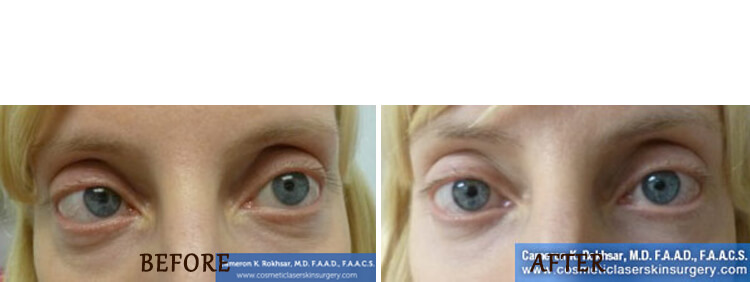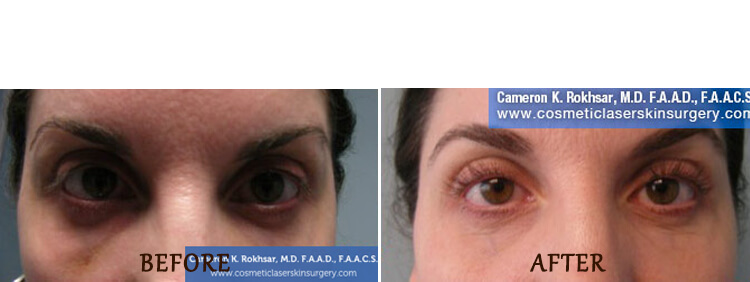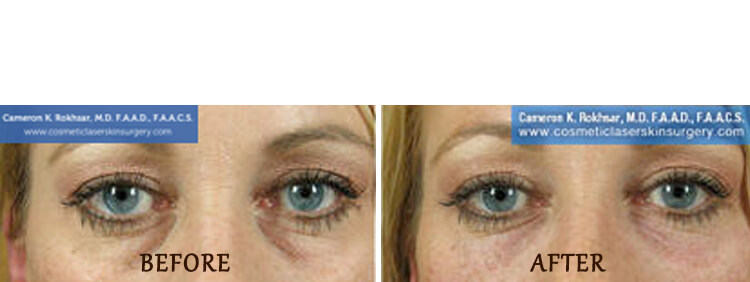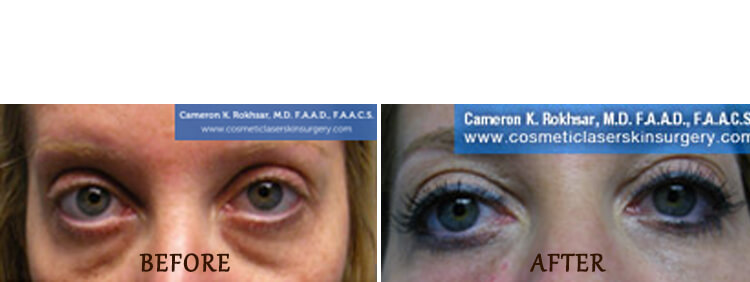Dark Circles Under Eyes Removal in New York
Dark Circle Treatment
Most people think that dark under-eye circles are caused by staying up late watching monster movies, or having that last drink the night before, or sitting up with your laptop trying to finish the quarterly report. Most people think that their behavior is somehow linked to dark under-eye circles.
Dark under-eye circles1 are actually a by-product of the very same mechanism that produces bruises. Changing your behavior will, in almost every case, NOT get rid of your dark under-eye circles.
Dark under-eye circles begin in the capillaries, the tiny blood vessels that web the delicate skin around the eyes. Now, your capillaries are so small that red blood cells sometimes have to line up, single file, to get through. Frequently, red blood cells get lost and wander into the surrounding skin. This isn’t a problem–it happens all the time–and your body has a mechanism to mop up these escapees. Enzymes in your body break down the red blood cells, including their hemoglobin (the molecule that gives them their distinctive red color).
How Do I Get Rid of Those Dark Circles Around My Eyes in Manhattan?
If you’re plagued by chronic dark circles, talk with a dermatologist about more aggressive options. For patients with excessive pigmentation, lightening creams, chemical peels or laser resurfacing may be an option2. Lightening agents, such as hydroquinone acid, work gradually by training under-eye cells to produce less pigment. Non-prescription strength lighteners are available but can take two to three months to effect a noticeable improvement. Chemical peels and laser resurfacing remove layers of damaged skin and help to make pigmentation less visible. Each option comes with cautions, and Dr. Rokhsar can determine the best approach for your skin.
Dark Circles Under Eyes: Before and After
*Results may vary.
Dark circles are caused3 by one of three primary reasons:
- Bone structure: If you have deep-set eyes, shadowing contributes to the dark color under the eyes. Your best bet: camouflage. Look for concealers with yellow undertones, which counteract the bluish cast to under-eye circles.
- Pigmentation: Genetic hyper-pigmentation is the most treatable form of dark circles. Your best bet: chemical peels or laser resurfacing.
- Vasculature inflammation: Late nights, allergies and nutritional deficiencies can enlarge the blood vessels beneath the thin under-eye skin. Sounds cliché but drink that water, get your beauty sleep, eat a healthy diet and avoid cigarette smoke.
Dark Circles Under Eyes Removal FAQ
What causes dark circles under eyes?
Dark circles under the eyes are a common cosmetic concern that can make people appear tired or older than they actually are. Dark circles under the eyes can be caused by various factors including being tired, allergies, atopic dermatitis (eczema), vascularity on the upper and lower eyelids, hollowness, true brown pigment, eyebags (fat), anatomy like recessed skull bones like the orbital rim, and the normal aging process. Dehydration can also cause the skin beneath the eyes to appear dull and sunken. Lack of sleep, poor sleeping habits, and hyperpigmentation due to increased melanin production from rubbing, the sun, irritation from cosmetic creams or products, and allergies can also lead to the development of dark circles under the eyes. Visible blood vessels beneath the skin’s surface can create dark shadows that are particularly noticeable in individuals with darker skin tones. In children, nasal congestion can cause veins around the nose to become dilated, leading to the appearance of shadowy dark circles under the eyes. Certain lifestyle choices such as smoking, excessive alcohol consumption, and poor nutrition can contribute to the development of dark circles under the eyes.
To reduce the appearance of dark circles under the eyes, a variety of treatment options are available. These may include using cold compresses, applying creams containing retinol or vitamin C, getting enough sleep, staying hydrated, and reducing salt intake. However, persistent dark circles that do not improve with lifestyle changes may improve with non-surgical procedures such as dermal fillers or laser treatments. Dr. Rokhsar likes to use restylane or collure in the lower eyelids for treatment of hollowness. He can use vascular lasers such as the Vbeam laser or the Cool Touch Varia for the treatment of purpleness or vascularity. Dr. Rokhsar also likes to resurface the skin of the eyelids with either the Fraxel laser or the co2 laser to generate new skin. This is a complex problem and you need to see Dr. Rokhsar in person to find out what the best strategy is for your specific issues and your individualized goals.
How to prevent under eye bags?
Under eye bags can be caused by a variety of factors, such as aging, genetics, fluid retention, and allergies. Here are some tips on how to prevent under eye bags:
- Avoid allergens when possible. Try non-prescription allergy medications. Talk to your healthcare provider about prevention strategies if you develop under-eye reactions due to hair dyes, soaps, cosmetics, or other allergens.
- Use cosmetics with care and avoid getting them in your eyes.
- Maintain a healthy lifestyle by getting enough sleep, eating a balanced diet, and exercising regularly.
- Use a cool compress such as cucumbers or cold tea bags to help reduce puffiness.
- Limit your alcohol intake and quit smoking, as both can cause inflammation and contribute to puffy eyes.
- Use caffeine-based eye creams that can help reduce under-eye puffiness.
- Be gentle with your eye area and avoid rubbing, tugging, or pulling the skin around your eyes.
- Avoid intake of too much salt or sodium.
- Avoid rubbing your eyes. This causes wrinkling and darkening of your skin.
- Get ahead of your allergies in allergy season by taking antihistamines and nose sprays before the allergy season starts.
Remember, prevention is key, but if you already have under eye bags, it is essential to identify and address the underlying cause. In some cases, medical treatment may be necessary. During a consultation, Dr. Rokhsar can discuss with you options for improving the appearance of dark circles under the eyes.
How to reduce under eye bags?
- Use a cool compress. Applying a damp, cool washcloth or cucumber slices to the skin under and around your eyes for a few minutes can help reduce puffiness.
- Cut down on fluids and salt before bedtime and limit salt in your diet. Both of these can contribute to fluid retention and exacerbate under eye bags.
- Get enough sleep. Not getting enough sleep can cause fluid to accumulate under your eyes, leading to puffiness. Aim for 7-8 hours of sleep per night.
- Use a good daily moisturizer. Keeping the skin around your eyes healthy and hydrated can help prevent bags from forming. Choose a gentle formula for use around your eyes.
- Try a retinol eye cream or eye cream with caffeine. Retinol promotes new skin turnover, improving bags, wrinkles, and fine lines, while hyaluronic acid keeps the thin skin under the eyes moisturized and supple. Caffeine causes blood vessels to constrict and can help reduce puffiness under the eyes.
- Limit or eliminate alcohol consumption. Alcohol dehydrates your body and skin, causing the delicate area around your eyes to appear sunken and dark. This can exacerbate the appearance of bags.
- Try skin treatments. Laser resurfacing, chemical peels, and fillers can help tighten skin, improve its tone, and reduce the appearance of under eye bags. Dr. Rokhsar would be happy to discuss these options with you during your consultation.
How to remove eye bags permanently?
Eye bags can be a pesky problem that can make one look tired or older than they are. Here are some ways to remove eye bags permanently:
- Laser resurfacing: This treatment for dark circles uses a laser therapy to remove surface layers of wrinkly skin in the under-eye area and stimulate new collagen growth, resulting in firmer skin. Results can last years, depending on your skin type and sun exposure. Dr. Rokhsar will advise you which laser system such as the CO2 laser or the Fraxel laser is right for you. You may also benefit from treatment with a vascular laser or a pigment.
- Chemical peel: A chemical peel also treats wrinkly under-eye skin by removing superficial top layers. This is a tricky procedure and you should seek the help of an MD board certified dermatologist who has years of experience in this field.
- Petrolatum jelly: Massaging a small quantity of white petroleum jelly on your fingertips onto the under-eye area for 15 to 20 minutes can help reduce eye bags.
- Hydration: Drinking plenty of water can help reduce the appearance of eye bags.
- Decrease salt intake: Controlling salt intake can help reduce eye bags.
- Reduce alcohol consumption: Limiting alcohol intake can help reduce eye bags.
- Reduce sugar: Cutting down on sugar can help reduce eye bags.
- Quit smoking: Smoking can lead to premature aging and contribute to the formation of eye bags. Quitting smoking can help reduce their appearance.
- Increase vitamin C intake: Eating foods rich in vitamin C can help promote collagen production, which can improve the appearance of under-eye skin.
- Collagen-rich foods: Consuming foods high in collagen, such as bone broth or collagen supplements, may help reduce eye bags.
- Dermal filler: Dr. Rokhsar is an expert injector and fillers can help even-out the skin under the eyes to reduce the appearance of under-eye bags.
- Consider eyelid surgery or blepharoplasty.
How to get rid of genetic eye bags?
Genetic eye bags are a common cosmetic concern that can be difficult to get rid of completely. While there is no guaranteed method for completely eliminating eye bags caused by genetics, there are non-surgical procedures that can reduce their appearance.
Laser resurfacing can help to tighten skin around the eyes to remove fine lines and wrinkles which can also help reduce the appearance of under eye bags. Dermal fillers correctly placed under the eye can lift up the skin and give a more even appearance. Dr. Rokhsar is an expert in filler injections and teaches other doctors how to correctly inject fillers to achieve the desired results. During a consultation, he will advise you on which fillers are ideal for the under eyes.
If you are looking for longer-lasting solutions, eyelid surgery may be an option for persistent or bothersome under-eye puffiness.
It’s important to keep in mind that genetics play a significant role in the appearance of eye bags, so it may not be possible to completely eliminate them. However, with consistent efforts and lifestyle changes, you may be able to reduce their appearance and improve the overall health of your skin.
New York Office Locations
Upper East Side Manhattan Office
121 East 60th Street, Suite 8AB New York, NY 10022
(212) 285-1110
Long Island Office
901 Stewart Ave, Suite 240, Garden City, NY 11530
(516) 512-7616
Request an Appointment
References
- Dark Circles Under Eyes. Available: https://www.realself.com/concerns/dark-circles-eyes.
- 5 Solutions for Dark Circles. Available: https://www.webmd.com/beauty/features/dark-circles.
- What Causes Dark Circles Under Your Eyes? Available: https://www.healthline.com/health/dark-circle-under-eyes.









 Dr. Rokhsar was chosen by
Dr. Rokhsar was chosen by 






